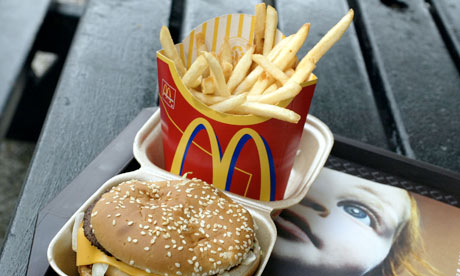
Bad news for salad dodgers – McDonald's will now display dietary information at its 1,200 UK restaurants, outlining just how many calories are in its products. Suddenly it could be a lot harder to justify choosing a burger over a salad.
There are some surprises. While I expected a Big Mac to contain in the region of 490 calories, I was surprised that a medium milkshake has 420 calories, medium fries contain 330 calories and a Chicken Legend burger, which I stupidly assumed would contain fewer calories than other sandwiches, contains a whopping 535 calories.
The recommended daily average calorie intake for men is 2,500, and for women it's 2,000. This means if I waltz into a McD's and order a Chicken Legend with medium fries and a milkshake, I'll be consuming 51.4% of my recommended daily calories. For a woman, the percentage would rise to 64.25%.
The least calorific main meal would be six chicken nuggets with no dip (boo!), a garden side salad and a bottle of water or a medium black coffee, which would result in a man consuming 10.4% of his daily intake and a woman chowing down 13% of her recommended daily average.
But will displaying this information make anyone change their order? I'd be as likely to order a lower-calorie option as I would be to walk into a Chinese restaurant and order roast chicken and chips – it's simply not what I want from fast food. Does anyone really walk into McDonald's or KFC and not know there are healthier choices available? Moreover, how can anyone make an informed choice about food while staggering into a fast food outlet after the pub has closed?
The McDonald's move comes in response to the government's Public Health Responsibility Deal, which has also seen major chains such as Pret a Manger, JD Wetherspoon, Harvester, KFC and Pizza Hut introduce calorie labelling in their outlets. Greggs, Starbucks and Burger King have also signed up to the government's Out of Home calorie labelling pledge and will introduce it in their outlets from next year.
The Department of Health says that calorie labelling "makes people more aware of the energy content of their foods and does influence people's choices". With McDonald's serving 3m meals a day, the government believes this will have a huge effect on the high street and will help people to make healthier choices when eating out.
But recent studies on risk compensation behaviour suggest that when people take vitamins they become more likely to take other risks with their health, such as smoking or eating bad food. So there is an argument that by knowing how many calories are in fast food meals, people might order a low-calorie lunch then follow it up with a calorific cake later in the day.
I think there's something in this line of thinking. Whenever I play football I think nothing of having a couple of beers (or more) straight afterwards, part of me maintaining that the exercise beforehand somehow cancels out the negative effects of the alcohol. If I have a salad for lunch I'm definitely more inclined to have a big blow-out at dinner, safe in the knowledge I was virtuous earlier in the day so it doesn't matter.
And McDonald's own research shows that calorie labelling makes less of a difference than you might think. While eight in 10 of its customers believe all companies should display simple, visible calorie information, fewer than one in five (17%) told the fast food chain that calories on menu boards would make them think more about what they are eating.
Which begs the question, is there really any point?

